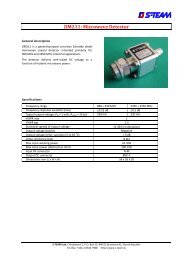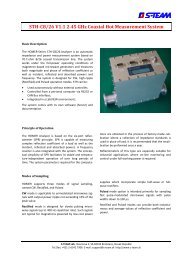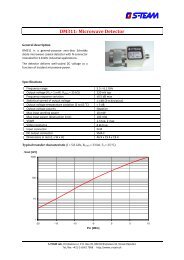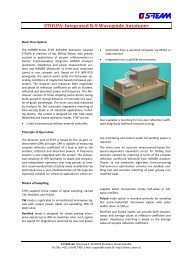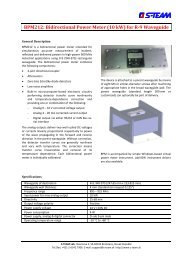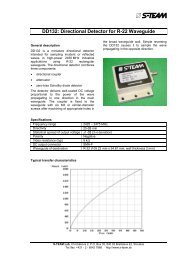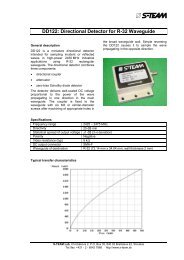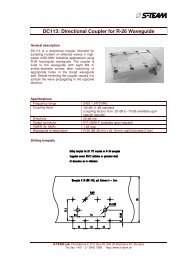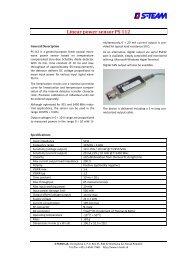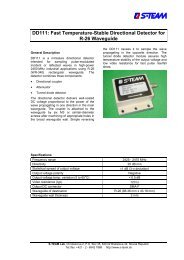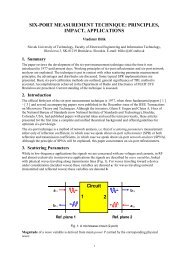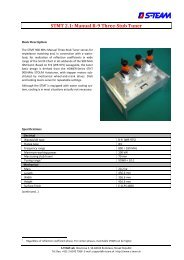Homer Hot Measurement and Tuning System - S-TEAM Lab
Homer Hot Measurement and Tuning System - S-TEAM Lab
Homer Hot Measurement and Tuning System - S-TEAM Lab
You also want an ePaper? Increase the reach of your titles
YUMPU automatically turns print PDFs into web optimized ePapers that Google loves.
containing 4 separate channels of precision programmable amplifiers (PGA) followed by A/D converters (ADC).<br />
Solid-state switches preceding the detectors serve for capturing offsets of the DC circuitry (apparent signals in<br />
absence of microwave power), which must be subtracted from the measured voltages V 1 to V 4 . The switches are<br />
controlled by a digital input/output (DIO) portion of SD-2000. In a single-board computer (SBC), connected with<br />
SD-2000 via PC/104 interface, the digitized voltages undergo a correction routine which eliminates nonlinearity <strong>and</strong><br />
temperature dependence of the detector transfer characteristics. The inner temperature is measured by a sensor with<br />
serial output, connected to SD-2000 by means of I 2 C bus. The corrected voltages along with signal frequency <strong>and</strong><br />
stored SPR calibration data are used to compute the reflection coefficient <strong>and</strong> incident power P i .<br />
Accurate knowledge of signal frequency is a precondition for accurate measurement. Since magnetrons used in<br />
industrial applications are free-running sources with frequency depending on working conditions, frequency is not<br />
known in advance but must be measured. A frequency counter is therefore integrated with the system. The counter<br />
uses a separate directional coupler (Frequency Coupler) of basically the same design as the reference coupler. The<br />
coupled signal frequency is divided in a microwave prescaler down to about 50 – 100 MHz, which is then measured<br />
by a 150-MHz counter (CNT) implemented in SD-2000. Gating intervals down to 16 s plus the triggering built in<br />
the SD-2000 software enable reasonable measurement even of pulsed signals with pulse duration down to about<br />
100 s.<br />
The system communicates with an external controller (e.g. a personal computer) via RS232 or CAN Bus interface,<br />
the latter being implemented in SD-2000. Another function implemented in SD-2000 is a full control (MC in Figure<br />
1) of three stepper motors for the purpose of automatic impedance matching.<br />
Residing inside SBC is <strong>Homer</strong> firmware, which is a system of files that control its operation <strong>and</strong> behavior. The<br />
firmware consists of an assembly of executable files (Servers), memory files (containing individual information, like<br />
system identity <strong>and</strong> calibration data) <strong>and</strong> auxiliary configuration files, defining <strong>Homer</strong> startup behavior. One of the<br />
Server program at a time runs in SBC, performing all tasks associated with acquiring data, computations of results,<br />
receiving comm<strong>and</strong>s from PC <strong>and</strong> sending responses <strong>and</strong> measurement results. The results include real <strong>and</strong><br />
imaginary part of measured <strong>and</strong> load (deembedded) reflection coefficients, power incident on <strong>and</strong> reflected from<br />
DUT, frequency, internal temperature <strong>and</strong> error byte. In case of Autotuner the data include tuning stub positions <strong>and</strong><br />
motors status. The configuration files, read by Server at its start, contain various <strong>Homer</strong> power-up settings.<br />
While the configuration files can be transferred from one <strong>Homer</strong> to another to assure the same startup behavior, the<br />
memory files are strictly individual. An attempt to transfer them to a non-native <strong>Homer</strong> results in raising <strong>Homer</strong><br />
Identity Error <strong>and</strong> refusal to perform except some basic operations like file transfers.<br />
More about the firmware see in <strong>Homer</strong> Internal Files.<br />
The Windows HomSoft application described in this document enables full <strong>Homer</strong> control, receiving of results,<br />
converting them to a variety of formats, displaying <strong>and</strong> storing them, as well as long-term monitoring <strong>and</strong> data<br />
logging.<br />
Learn also about <strong>Homer</strong> Analyzer measurement accuracy.<br />
<strong>Homer</strong> Versions<br />
Many <strong>Homer</strong> Analyzer <strong>and</strong> Autotuner versions exist. They differ by the following main parameters:<br />
<br />
<br />
<br />
<br />
Frequency range (ISM b<strong>and</strong>)<br />
- 900 MHz (subb<strong>and</strong>s 896 MHz, 915 MHz, 922 MHz)<br />
- 2.45 GHz<br />
- 5.8 GHz<br />
Transmission medium<br />
- Waveguide<br />
- Coaxial<br />
Waveguide type<br />
Coax dimensions<br />
RS serial communication interface<br />
- RS232<br />
- RS422<br />
Maximum input power (can be ordered by customer)<br />
User's H<strong>and</strong>book <strong>Homer</strong> <strong>Hot</strong> <strong>Measurement</strong> <strong>and</strong> <strong>Tuning</strong> <strong>System</strong> Introduction 5



